Today, most of the current, in-print books that focus on work with the tambour needle are beading books. Occasionally, these books will have a chapter or a section on tambour embroidery, but for the most part, they focus on work with beads and sequins.
That’s ok! You can learn a lot about tambour embroidery from these books, too. I’m not knocking them – I’m just stating a fact. They’re mostly books on beading.
But if you want what I think is the best and most thorough book on all aspects of tambour work, primarily focusing on embroidery, you’ll have to scour libraries and out-of-print, used book sources for it.
The book is Tambour Work, by Yusai Fukuyama, published in 1987 by Dryad Press in the UK.
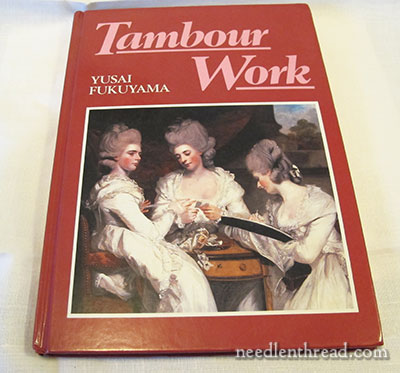
I first bought this book some 10 years ago, when I bought my first tambour needle. But at the time, I never did anything with either, beyond a brief dabble.
This book is not a huge tome. It’s not elaborate. It’s not complex. It’s a very simple, very clearly written and illustrated book on how to use the tambour needle primarily for embroidery. It is truly an instructive book, more than a picturesque book.
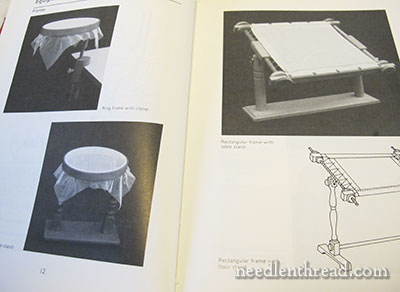
The book is completely printed in black and white – there’s not a lick of color in it – but don’t let that deter you!
The author begins with an explanation of the equipment used for tambour work. He shows a variety of different types of hoops and frames that can be used, and even gives some substitutions if you don’t have any of them.
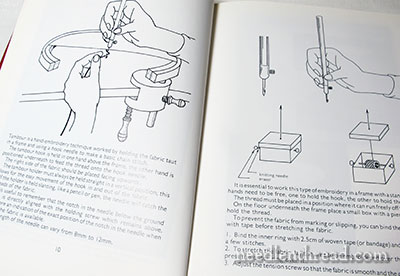
Using very clear line drawings, he demonstrates the set-up for working with a tambour needle, how to hold the needle, what to do with your thread, and so forth.
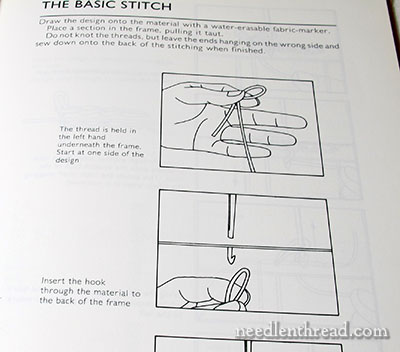
Again, with line drawings, he illustrates and explains the movements involved in tambour embroidery. He includes all the pertinent details of starting and ending threads, of inserting the hook, wrapping the thread, turning the hook, removing the hook – everything you need to know to successfully maneuver the tambour hook is here.
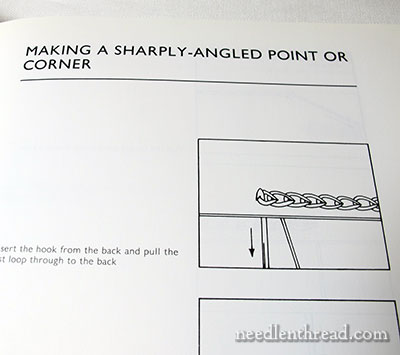
He covers any of those little difficult moves, too, like turning a sharp corner.
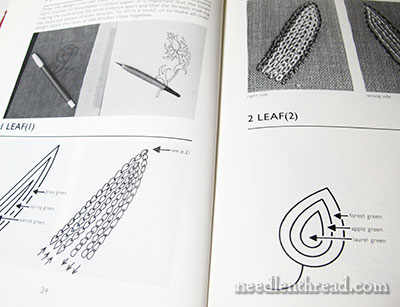
Then, he presents different shapes or elements, and demonstrates how these would be embroidered – he illustrates the path of the chain stitched lines, where they should start and end, and what the element should look like when complete.
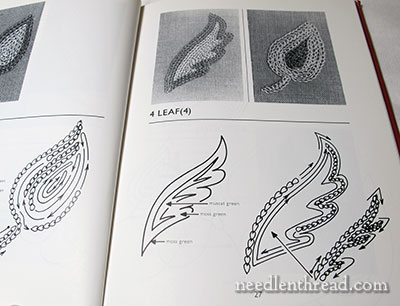
These pages are priceless for one who wishes to learn to fill shapes with tambour embroidery in a way that makes sense and looks nice.
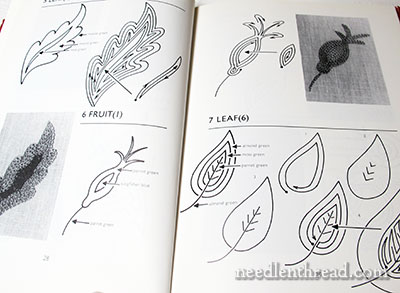
Besides leaf shapes, he covers fruit shapes…
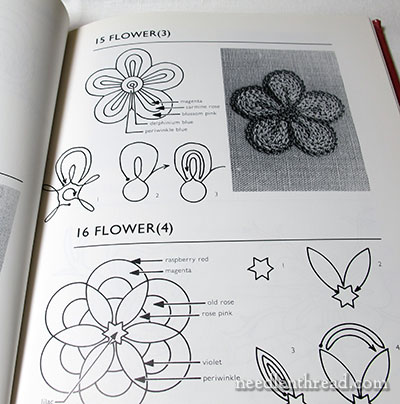
…and flowers.
These are perfect for practice! I love how he shows start and stop points, directions of stitching, turning points, and so forth, for each element. It’s as if the author anticipated the beginner’s every quandary, and took each into consideration when preparing the book.
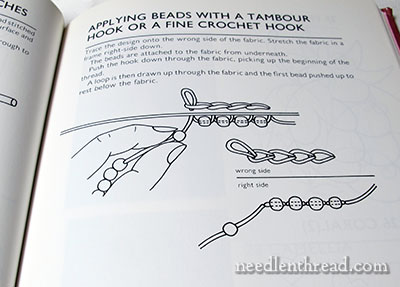
In the instructional area, there’s a little blurb on beading, and a few samples for beading and sequin work.
There’s also a little section on couching with tambour work.
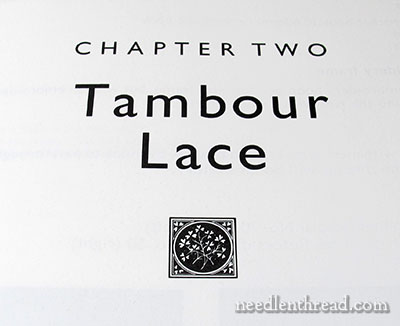
The second part of the book is devoted to tambour lace – the embroidering of machine-made nets with a tambour hook. Though specifically focusing on lace here, much of the information can apply as well to tambour embroidery on regular fabric.
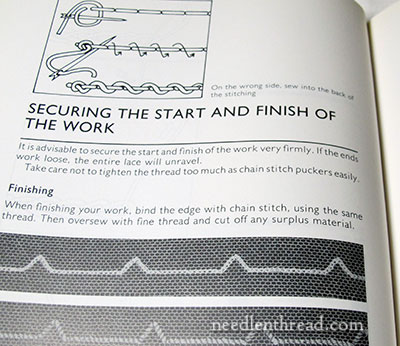
There are some differences, though. For example, starting and securing the threads is slightly different, so he points out the best way to accomplish starts and ends when working on net.
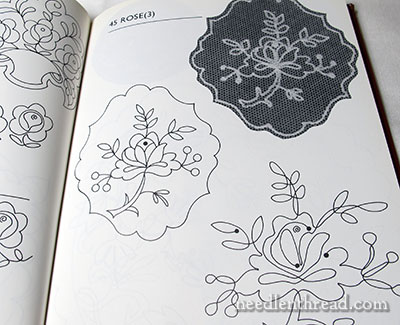
And then, the practice motifs are pretty much the same layout as in the embroidery section. Line drawings are given, with clear starts and stops, with the stitching path marked, and a finished sample is shown.
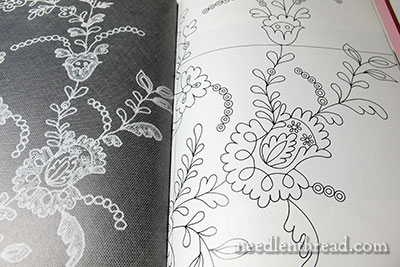
There are all kinds of nice lace designs here, which could also translate into surface embroidery designs.
At the end of the book, Yusai Fukuyama provides a list of suppliers around the world, too, but unfortunately, many of them are now defunct.
Where to Buy Tambour Work
You can find Tambour Work by Yusai Fukuyama through the following book affiliates and used book sources:
Tambour Workon Amazon in the US – there were a few “less expensive” copies available earlier, but I’m not sure what they’re running now.
Check eBay as well. Right now, the one listed is too expensive, in my opinion, but you never know if someone will list it again soon.
Possible Alternative
You can also try looking for Tambour Work: 80 Patterns for Lacemakers and Embroiderers by Yusai Fukuyama. I’m not sure if it’s the same book or not, but I suspect it is. It was published in 1997 with a different cover, but the description sounds the same. It’s also quite pricey through used book sources, but Blackwell’s in the UK carries it for a relatively reasonable price. It does not ship immediately, though.
Check Your Library!
Finally, before squandering large funds on the book, do check your library! If they don’t have it, see if they can get it for you through interlibrary loan.
Books like this also turn up at library book sales and in thrift stores (or “op shops”) for practically nothing. I’ve bought books at library book sales for twenty-five cents that are going for $100+ through used book sources online. If your nearest large city has a large library, find out when they have their library book sales and make plans to attend. There’s usually a cover charge to get in on the first opening, but oh, the bargains you’ll find!







Dear Mary
This looks such an interesting must have book on Tambour but unfortunately the prices are to much for me to be able to attain the book, I would love the Chapter on lace and to be able to embroider lace would be wonderful. I would love to learn how to sew and twist and create Tambour embroidery as I have some ideas on embroidering with my Tambour needle and one of those is lace. Anyway thanks for showing us inside the book and the review on the book perhaps they might re-print it.
Regards Anita Simmance
Hi, Anita – I know! It’s super expensive now. About a month ago, there were copies available that we’re not nearly as expensive, but the prices seem to have jumped up quite a bit! Did you check that alternate book idea at the end of the post, available from Nlackwell’s in the UK? I really think it’s the same book, but I don’t have a copy to compare. The descriptions sound the same…. Also, try the library, if you have one close by. It really is an excellent book for learning to use the tambour hook. Not worth the prices being asked, though. I’ll have some tutorials up in the future, too, so that will hopefully help. – MC
Hi Mary
Yes I did check Blackwells they are cheaper but they do not have any of the books in stock. I really am looking forward to your tutorials can’t wait I’m so excited to start Tambour stitching. Thanks for your comments
Regards Anita Simmance
When I saw your post and the pictures, with tambour embroidery AND tambour lace, I didn’t even finish my reading and run to Amazon to be the first one to try and get a copy !
The only book I found about tambour lace has been translated in English and French from Flemish and is nearly impossible to understand (though I’m French and can read English pretty well).
Thanks A LOT for the posts and resources about tambour work !
I don’t know of any French books (except this free online one: http://broderiebeauvais.free.fr/CHapitre%202.html), but if you search for ‘Point de Beauvais’ there are quite a few French websites on tambour embroidery.
Wonderful Mary! Your articles are such a welcome sight to my inbox every day! You work hard and do such a beautiful, in depth professional job. I just love it! Thank you!!
Thank you for the book review on Tambour Work. I am a big time crocheter so this has always interested me. Seeing your project has again peaked my interest in this type of work. The book Tambour Work can be found at Lacis.com for $25. Mine is on the way! Along with all the other necessary items. I am also continuing to find other items I want to complete that you have on your site such as the Tallifero Royal Persian Crewel Design. I have to say I enjoy your work. Thank you!
Silent Stitches has a soft cover version of this book (USD 24.95) which was reprinted in 2007. See http://www.silentstitches.com/Books.htm for details
Thanks, Kimberly! I’ll add that link up in the article, too. Excellent!
This book is also available new, in paperback from Hedgehog Handworks for $25.00.
Ahhhh! Thanks, Joady! When I wrote the article, I used the search feature on Hedgehog to see if you might have the book…but it didn’t come up. I just found it now under techniques and added a link. Thanks for letting us know! – MC
Thanks for reviewing this, Mary. Old out-of-print Dryad books do turn up in charity shops and on second-hand bookstalls from time to time (here in the UK, at any rate). Now I know this is a useful one, I shall add it to my list and pounce if I see it. It may take a few years to find it at a price I can afford, but that’s the joy of really practical embroidery books: they will still be just as useful when they eventually turn up.
Hi Mary, the Tambour Work book is also at Lacis for $25.00.
Rose Mary Muller
This is from Amazon today 11/6/13
10 Used from $75.87 7 New from $170.23
Paperback
5 Used from $76.00 3 New from $80.00
I got it yesterday from Amazon UK for “only” £25 and it’s £54 today ! I think I was lucky to hurry up !
This looks like a wonderful book. I love color photos for eye-candy and inspiration type books, but sometimes the color gets in the way. Especially if the colors tend to blend in with each other, the needle, hands or shadows. Or if I just don’t like the colors. Or if the photogapher is trying to be “artistic” rather than show the real subject.
Found this book at Silent Stitches for $24.95
http://www.silentstitches.com
Hi, Suzanne – thanks! I added that link to the article yesterday, so folks can find it there, or at Hedgehog Handworks – both places carry it new. – MC
Hi, Mary.
I bought that book from Amazon a couple years ago – haven’t actually done any work from it yet, but I second your opinion, it gives very clear instructions and I think it will be good instructions . . . when I get around to that project . . . . 😉
Yes Mary that’s the book I was talking about when you reviewed the other two Tambour books. I’m glad you liked it!
I just received my second-hand copy of “Tambour Work!” Most def worth the money :-)! As you mentioned excellent instructions and drawings! I am so glad I found your review – thank you!
Thank you for the review! Is this the same book? http://bookshop.blackwell.co.uk/bookshop/product/Tambour%20Work/9780713483291
I’ve checked the ISBN but they don’t match. I wonder if it’s similar though. Do you know by any chance? 🙂
Hi, Adoria – without seeing the inside, I’m not sure. I suspect it is, because I don’t think the author wrote two books, but I can’t be sure. When I get a chance, I’ll research it further. But I’m guessing it’s a reprint.
Apologies Mary for resurrecting this old article, but you are badly at fault for getting me hooked to tambour (!) and embroidery more general.
I bought the “Tambour work” book and also managed to locate (with great difficulty) “Broderie de Luneville” (which you reviewed here: https://needlenthread.wpengine.com/2013/10/tambour-embroidery-three-instructional-books.html)
The instructions for the basic stitches do vary. Yukusai does not turn the hook, and makes the stitches going in the direction opposite from where the knob is facing. The “Broderie…” instead (like your instruction video) instructs me to turn the hook 180 degrees twice (below and above the fabric, so the end position is the same as Yukusai’s), but then makes the stitches in the opposite direction as Yukusai.
Apart from the direction of stitching, it seems to me that nothing substantial changes between the two methods, and nothing really happens to the thread or the appearance of the stitch. Since I am an absolute beginner though, I thought I’d ask if you have any thoughts on this. Thank you, and thanks for your blog and the delightful books you sell!
I agree – it does not change much! So either method works! It may make a difference if you decide to extend into other techniques you can do with the tambour hook, but for the basic chain, either suffices.